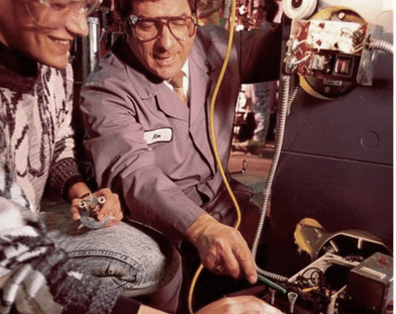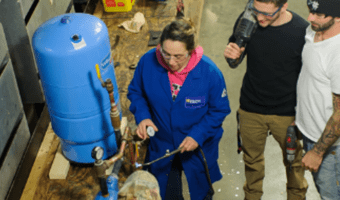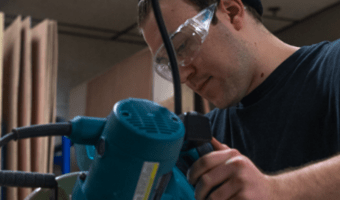Program Overview

Learn the introductory theory and practices of heating and plumbing. At the New England Institute of Technology’s plumbing and heating school, you will get hands-on experience in a laboratory setting that combines two distinct but interconnected areas: heating in residential structures and plumbing in residential, commercial, and industrial facilities.
In the Associate in Science in Plumbing and Heating (PLB) program, you can share classes and collaborate with your peers in architecture, construction management, welding engineering, and other allied professional trades programs.
Plumbing: The four-term plumbing program includes the study of basic tools, fabrication methods, fitting identification and usage, drainage, waste, and venting, approaches to design and install pipes, sewage disposal and treatment, water sources and distribution, and household and industrial maintenance of piping systems.
Students at the plumbing trade school also study sustainability aspects using rainwater harvesting and gray water technology.
Heating: In the heating program (distributed over two terms), we examine heating systems, such as steam, warm air, and forced hot water. Also presented are the burners used in conjunction with these systems and their associated control circuitry.
We specialize in electrical wiring, heat loss calculations, and system design for residential and commercial applications. We offer courses in the installation of heating systems, gas technology, solar heating systems, and introduction to welding.
The theory and hands-on training help you kickstart your career as a professional plumber or a heating technician. Graduates usually start apprenticeships under another master plumber.
Read MoreFull Description
We offer the Associate in Science Degree in Plumbing and Heating is a program offered jointly through the separate Plumbing and Heating Departments.
Plumbing/Heating is a comprehensive program designed to train students as entry-to-industry level technicians. Students learn the basic theory and practices of plumbing and heating and receive hands-on experience in a laboratory setting. The program offers a curriculum combining two distinct but interconnected areas: heating in residential structures and plumbing in residential, commercial, and industrial structures.
The four-term plumbing portion of the program includes the study of basic tools; methods of fabrication; fitting identification and usage; drainage; waste and venting; water piping methods and design; sewage disposal and treatment; water sources and distribution; and household and industrial maintenance. Sustainability issues using rainwater harvesting and gray water technology are stressed.
In the heating portion of the program (distributed over two terms), various heating systems are examined such as steam, warm air, and forced hot water. Also presented are the burners used in conjunction with these systems and their associated control circuitry. Special consideration is given to electrical wiring, heat loss calculations, and system design as they relate to a residential and commercial application. Included in the Heating Program are courses in the installation of heating systems, gas technology, solar heating systems, and introduction to welding.
The theory and lab experience at the heating and plumbing school includes designing, installing, troubleshooting, and servicing a vast array of heating units.
Graduates of the trade school can work in entry-level heating and plumbing apprenticeships. In addition, they are eligible to continue for a Bachelor of Science Degree in Business Management.
Job Availability in Rhode Island
According to the Bureau of Labor Statistics, over the next decade, there will be 51,000 openings for plumbers, pipefitters, and steamfitters each year. These jobs will replace those who will retire or exit the workforce.
Students of the plumbing associate degree should create a solid resume to start as an apprentice. This happens through personal recommendations, plumbing unions, and plumbing companies in Rhode Island.
According to the BLS, employment for heating mechanics will grow at 5% between 2020 and 2030. This equals about 38,500 openings each year to replace those who exit the workforce due to retirement.
The NEIT Campus that Offers the Plumbing Trade School Degree in Rhode Island
The NEIT campus that offers the plumbing and heating associate degree is the Post Road Campus, located at 2500 Post Rd, Warwick, RI 02886.
Plumbing and Heating Industry License Requirements in Rhode Island
The typical requirements to get a journeyman or master plumber license in Rhode Island are:
Journeyman Plumbing License
- Spend at least 4-years (8000 hours) as a registered apprentice plumber with hands-on training experience. This must include 576 hours of training in a state-approved program.
- Fill out and submit an application form and a fee of $75.
- Clear the exam for a journeyman plumber.
- Renew the license every two years for $72.
Master Plumbing License
- Show a copy of your current journeyman plumbing license.
- The journeyman license should show 5 years of work experience.
- Deposit a fee of $75.
- Clear the exam for a master plumber.
- Renew the license every two years for $240.
Earning Potential After Plumbing School in Rhode Island
Rhode Island is among the top states in the U.S. in terms of paying salaries to plumbers. Plumbing technicians in Providence and Johnston get $29,38 and $28.52 per hour, respectively. This is the same as the national average.
In addition, plumbers make over $6,500 per year for overtime and up to $401k in non-cash benefits. Plumbers who work on boilers earn 38.48% more than the average base salary of $28.52 per hour.
The heating and air conditioning technicians in RI make an average of $27.09 per hour and $401k of non-cash benefits. The $25.08 per hour salary in Warwick, RI, is close to its peer cities in Florida, Texas, Nevada, and Georgia.
Potential Career Opportunities
Getting an education in plumbing and piping systems can help you take up jobs such as:
Plumbing Technician
Heating Technician
Plumber Helper
Pipefitter
Steamfitter
The associate degree prepares you for plumbing apprenticeship programs where you can fine-tune your skills in on-the-job training under a master plumber.
Rhode Island currently employs 1,050 heating and air conditioning technicians and 2,240 plumbers, pipefitters, and steamfitters. Professionals with a college degree have the necessary skills and opportunities to pursue their careers as licensed journeyman plumbers.
FAQ
-
How long does it take to get an associate degree?
Associate degree programs typically take 18 months to complete.
-
What is the highest level of plumbing?
Master plumbers are considered the most skilled across the profession. Individuals must pass a licensure exam before attaining the title.
-
How many levels are there in plumbing?
Professional plumbing has three levels: apprentice, journeyman, and master. Each level has a specific requirement of experience and licensure. Most plumbers start as apprentices under other experienced professionals or companies.
-
What Is the Typical Entry-level Education to Become a Plumber at a Trade School?
You need a high school diploma or equivalent to start the heating and plumbing associate’s degree at trade schools.
-
What Are the Top Paying Industries That Employ Plumbers?
Top paying industries include power generation, transmission, and distribution, petroleum and coal products manufacturing, pharmaceutical manufacturing, pipeline transportation, and technical and trade schools.



